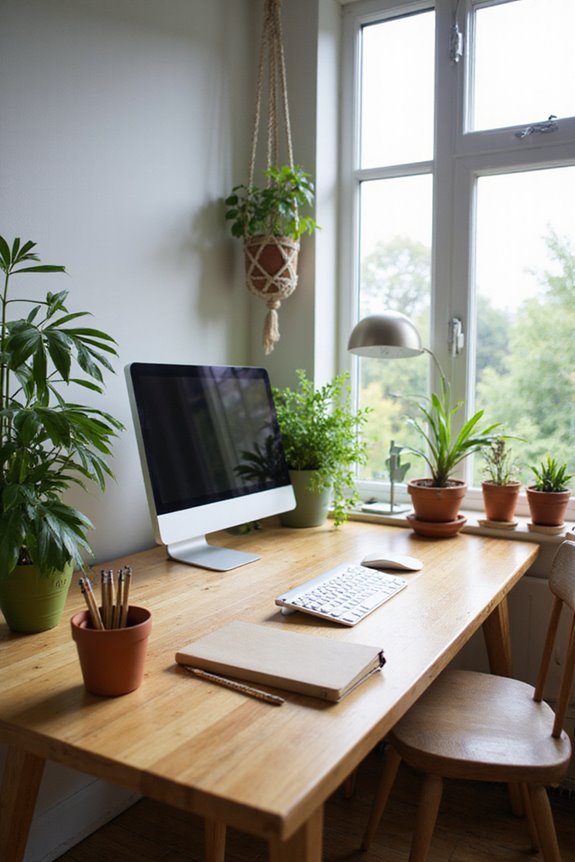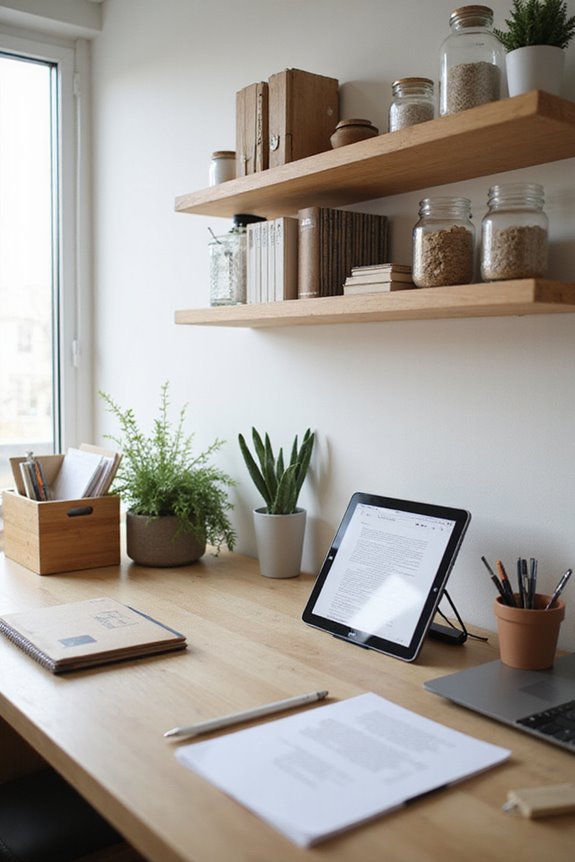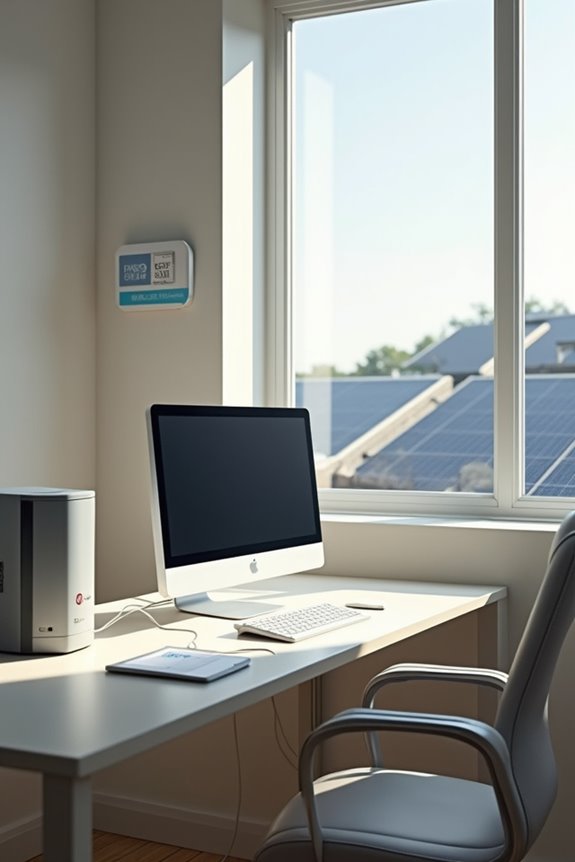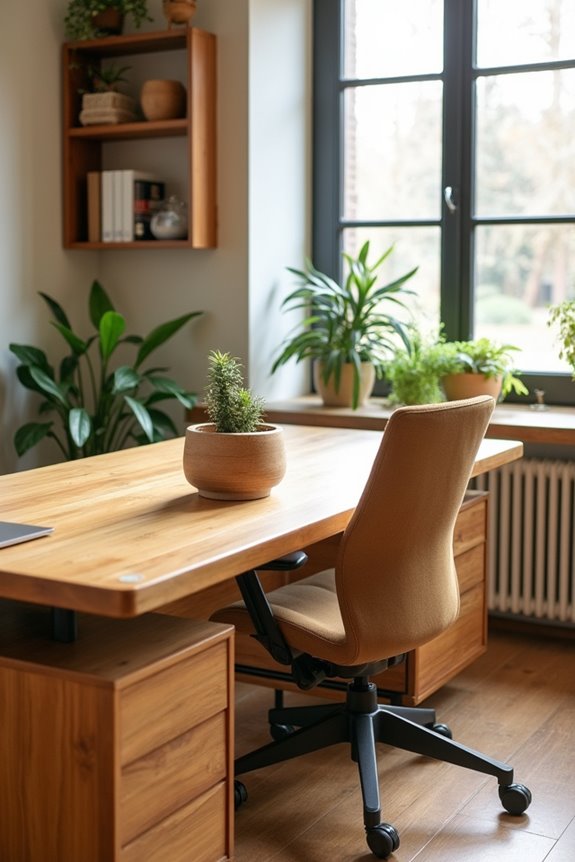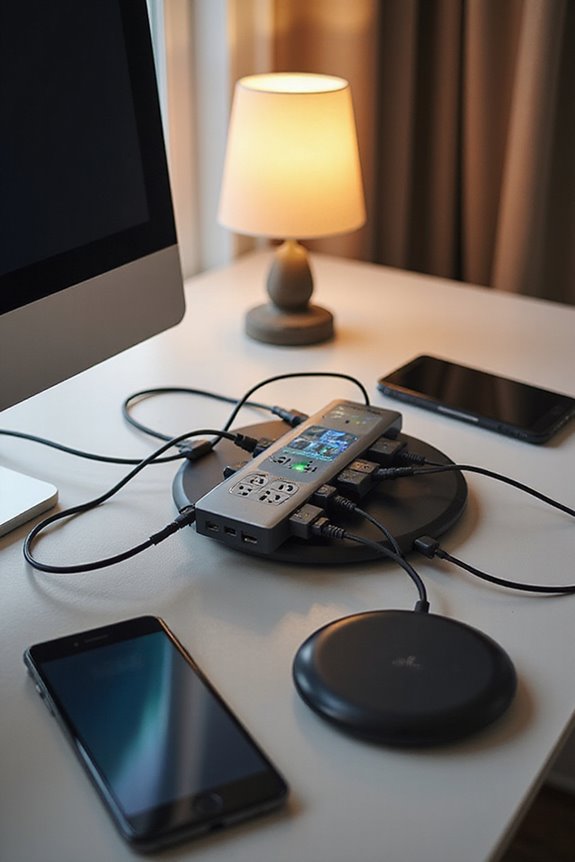To create an environmentally friendly home office, I focus on several key areas. First, I maximize natural light by positioning my workstation near windows and using light-reflecting mirrors. Then, I choose sustainable furniture made from reclaimed materials. I implement a digital workflow to minimize paper use, utilizing cloud storage for document management. Energy-efficient gadgets, such as smart thermostats and solar chargers, are essential. Finally, I enhance indoor air quality with plants and proper ventilation. Continue exploring for more insights.
Key Takeaways
- Position your workstation near windows to maximize natural light and reduce energy consumption.
- Choose sustainable furniture made from reclaimed wood and non-toxic materials to minimize environmental impact.
- Implement a digital workflow by digitizing documents and using cloud storage to reduce paper waste.
- Invest in energy-efficient gadgets and appliances, such as smart thermostats and solar chargers, for eco-friendly operations.
- Enhance indoor air quality by incorporating air-purifying plants and ensuring proper ventilation throughout your workspace.
Maximizing Natural Light and Energy Efficiency
When designing my home office, I’ve found that maximizing natural light not only enhances the space but also contributes to energy efficiency. Here are some strategies I’ve implemented:
- Assess Window Placement: I positioned my workstation near a window to capture as much natural light as possible.
- Keep Panels Below Window Height: I guaranteed workstation panels don’t obstruct any light.
- Use Mirrors Strategically: By placing mirrors, I reflected light deeper into the room.
- Maintain Window Clarity: I regularly clean my windows to maximize light transmission.
- Daylight Orientation: I oriented my room towards the best daylight direction.
Choosing Sustainable Furniture and Decor
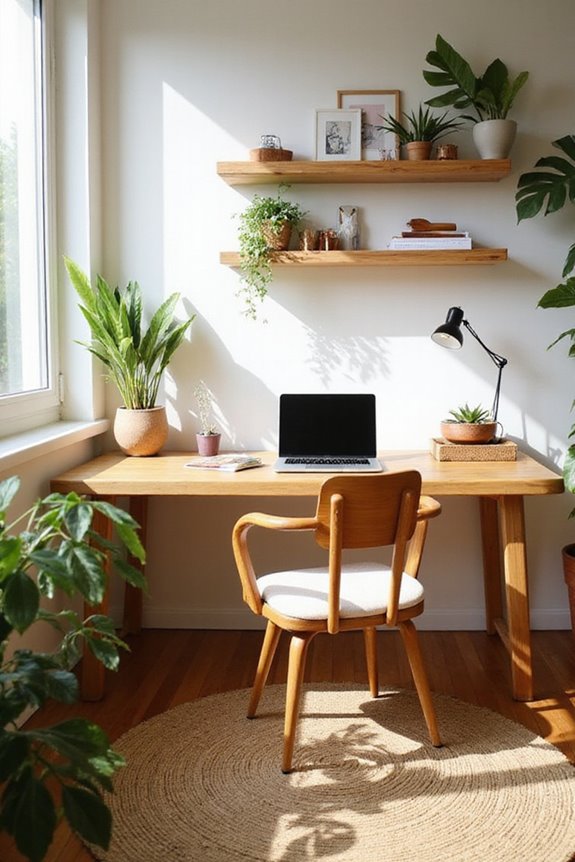
As I began to select furniture and decor for my home office, I recognized the importance of making sustainable choices that align with my environmental values. I opted for pieces made from reclaimed wood, which reduces the demand for new timber. For added durability, I chose items with non-toxic finishes and sustainable materials like bamboo and rattan. Incorporating recycled plastics into my decor also promotes recycling. I focused on natural fabrics for upholstery, ensuring they’re breathable and biodegradable. Local manufacturing was a priority to minimize transportation emissions. Additionally, I included air-purifying plants to improve indoor air quality, creating a healthier workspace while supporting eco-friendly practices. Each choice reflects my commitment to sustainability.
Implementing a Digital Workflow to Reduce Paper Usage
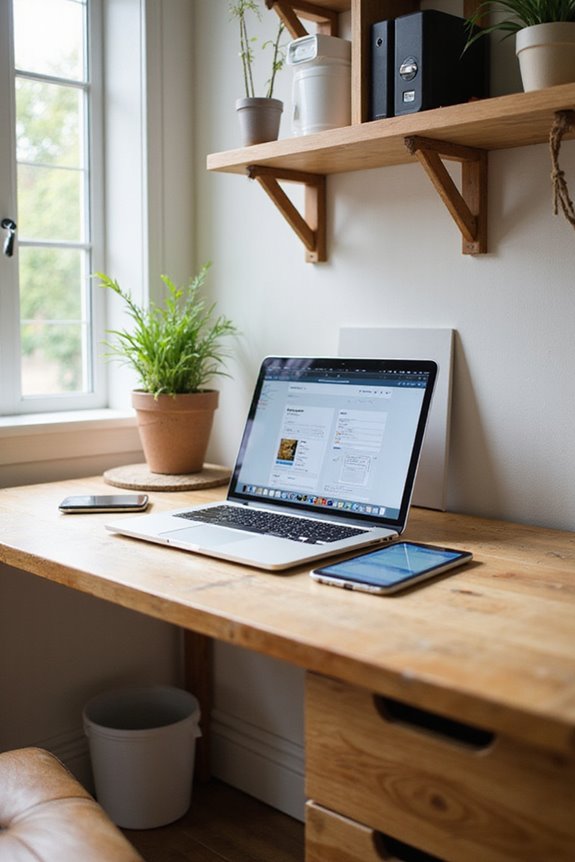
Implementing a digital workflow offers a practical way to complement the sustainable choices made in selecting furniture and decor for your home office.
- Digitize Key Documents: Start by scanning and storing existing paperwork. A document management system (DMS) can help organize and secure these digital files. Replace paper approvals with digital signatures to streamline contracts and forms.
- Adopt Paperless Processes: Use digital forms for tasks, automate workflows, and prioritize digital communication to minimize print reliance. Cloud storage is essential for securely storing your information without physical filing cabinets.
- Monitor Usage: Track your printing habits and set reduction goals to continuously improve your efforts. Educate your team on the benefits of a digital workflow to foster a culture of sustainability.
Investing in Eco-Friendly Gadgets and Electronics
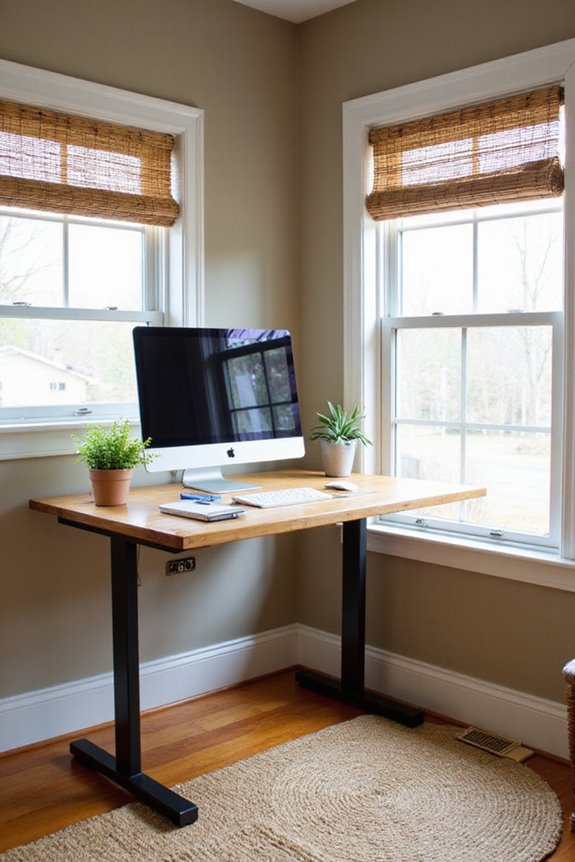
Investing in eco-friendly gadgets and electronics can greatly enhance both your home office’s sustainability and efficiency. Consider using solar chargers to reduce your reliance on electricity. Smart thermostats can optimize your heating and cooling, potentially saving you up to 23% on energy costs. Pair these with energy-efficient appliances and eco laptops made from sustainable materials, like the Acer Aspire Vero 16.
Additionally, implement energy monitoring systems and smart plugs to track and manage your energy consumption effectively. Don’t overlook the benefits of refurbished gadgets, which provide a sustainable upgrade option. Finally, choose biodegradable accessories to minimize plastic waste in your workspace. By integrating these tools, you’ll create a more environmentally friendly home office.
Enhancing Indoor Air Quality
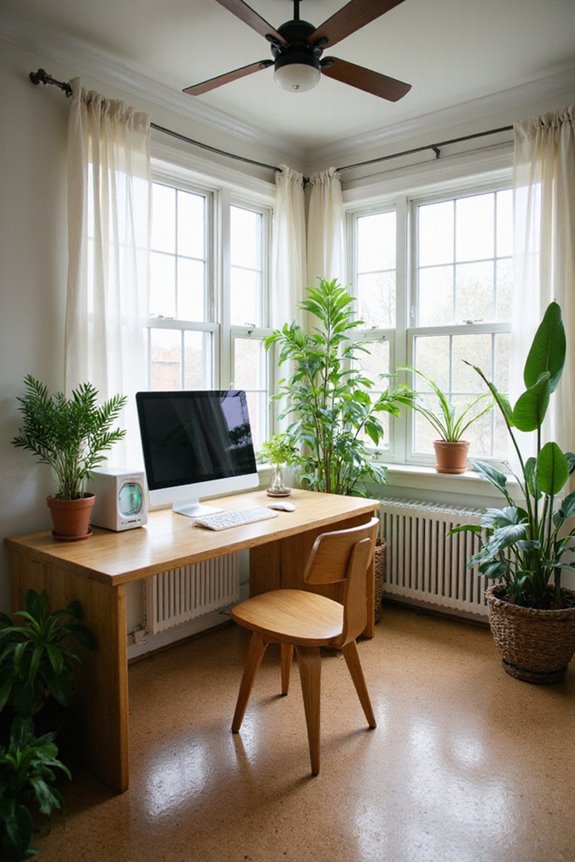
To create a productive and healthy home office, improving indoor air quality (IAQ) is crucial, especially since poor air quality can lead to decreased focus and overall well-being. One effective method is air quality monitoring; I regularly check levels of humidity, particulates, and VOCs. I also make certain to open windows and use energy-efficient fans for natural ventilation, which helps dilute indoor pollutants.
Incorporating air-purifying plants, like snake plants, enhances IAQ while adding a touch of nature. Additionally, I’ve installed a mechanical ventilation system with HEPA filters to continuously introduce fresh air and filter out allergens. By actively managing pollutant sources and maintaining superior air quality, I guarantee a healthier workspace for myself.
Maintaining Sustainable Practices for Ongoing Improvement

Creating a healthy home office environment involves not just enhancing indoor air quality, but also maintaining sustainable practices that contribute to ongoing improvement. To achieve this, I focus on employee engagement and sustainability feedback. Regular assessments help identify areas for improvement, while open communication channels encourage team members to share their thoughts on sustainability practices.
Here are some actionable strategies:
- Conduct energy audits to pinpoint inefficiencies.
- Implement digital documentation to reduce paper waste.
- Establish recycling programs for various materials.
- Use energy-efficient equipment and smart technologies.
Utilizing Energy-Efficient Lighting Solutions
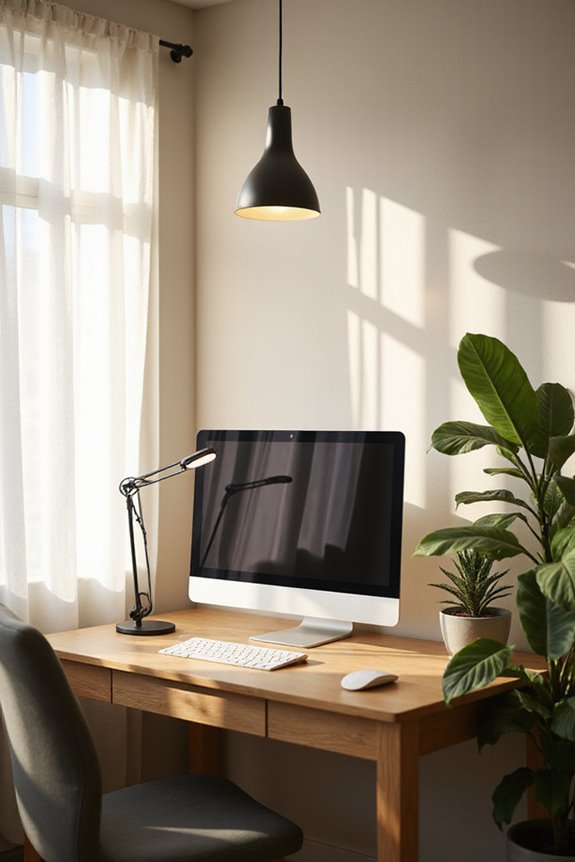
When considering how to optimize your home office, utilizing energy-efficient lighting solutions is essential for both sustainability and productivity.
- LED Benefits: Switching to LED lights is a smart choice. They consume less power, last longer, and emit less heat, which keeps my workspace cooler.
- Incorporating Smart Technology: Smart lighting solutions automate adjustments based on the time of day, helping create a tailored environment. I can control the brightness and color temperature easily, enhancing my focus and energy. Additionally, using lamps with adjustable brightness allows for customizable lighting that reduces eye strain.
- Layered Lighting: Combining ambient, task, and accent lighting allows me to customize my workspace for various tasks, ensuring ideal visibility.
Creating a Comfortable and Functional Workspace
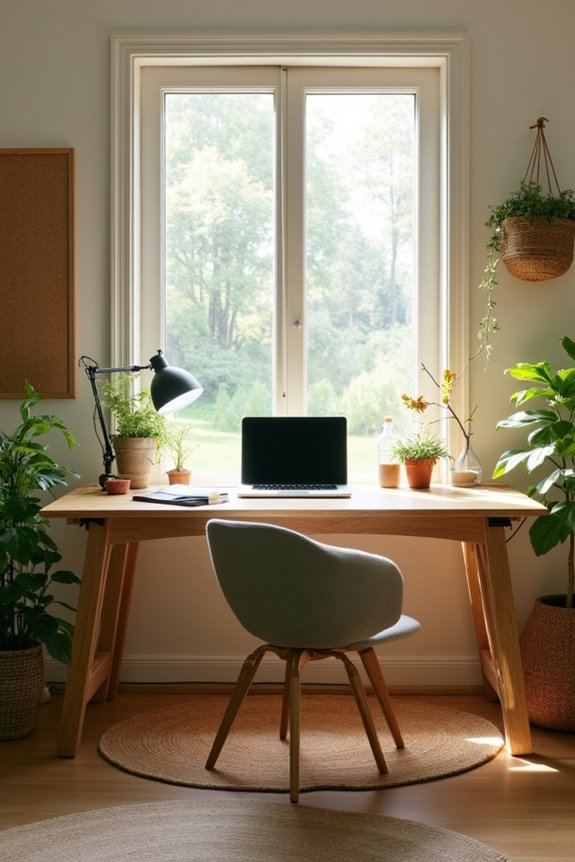
A well-designed workspace not only enhances comfort but also greatly boosts productivity. By prioritizing ergonomic design, I can reduce health issues like back pain, allowing me to focus on my tasks. Adjustable desks and supportive chairs are essential for personalized comfort. Incorporating natural elements, such as plants and ample natural light, can notably improve my well-being. Additionally, creating collaborative spaces encourages communication, fostering teamwork and creativity. Open office layouts, combined with flexible work areas, cater to different work styles and enhance interaction among team members. Investing in smart technology further supports remote collaboration, making it easier to connect with colleagues. By thoughtfully designing my workspace, I’m setting the stage for increased happiness and productivity. Moreover, using adjustable height desks can further promote better posture and comfort during long hours of work.
Frequently Asked Questions
How Can I Recycle Old Electronics Responsibly?
I always make sure to recycle my old electronics responsibly. I use e-waste recycling programs and consider electronic donations to local charities. It’s a great way to keep devices out of landfills and help others!
What Are Some DIY Eco-Friendly Office Decor Ideas?
I love creating a unique workspace with upcycled wall art and sustainable desk organizers. It’s amazing how old materials can transform into beautiful decor, making my office both stylish and eco-friendly while reflecting my personality.
How Often Should I Replace Air Filters in My Home Office?
I replace my air filters every 90 days to maintain air quality. Depending on filter types, like pleated or HEPA, I sometimes check monthly, especially if I have pets or allergies affecting my home office.
Can I Use Secondhand Furniture Safely in My Office?
Did you know that using secondhand furniture can reduce landfill waste by 70%? I always check safety standards and furniture materials to guarantee they’re non-toxic. It’s a smart, eco-friendly choice for my office!
How Do I Properly Dispose of Hazardous Office Materials?
When it comes to hazardous waste, I always follow disposal guidelines carefully. I separate materials like batteries and chemicals, ensuring they’re labeled correctly, and I take them to designated facilities for safe disposal.

